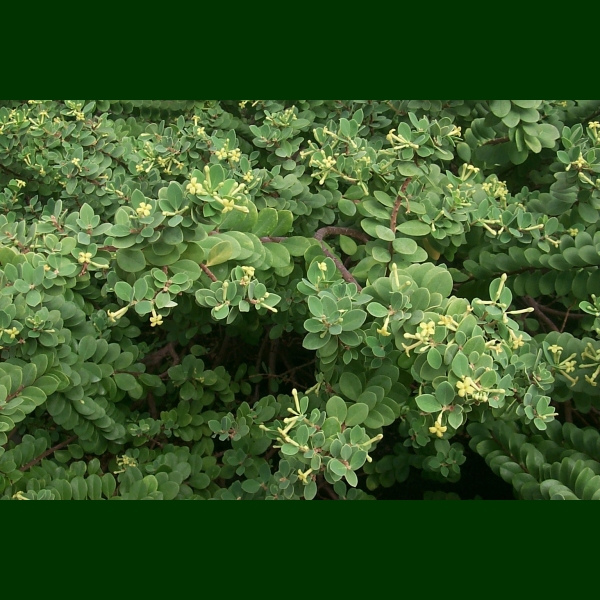 Hawaiian Name(s): ‘ākia, kauhi, ‘ākia manolo
Hawaiian Name(s): ‘ākia, kauhi, ‘ākia manoloScientific Name: Wikstroemia (12 species)
Vernacular Name: none
Family: Thymelaeaceae
Status: endemic
Authority: W. bicornuta Hillebr., W. forbesii Skottsb., W. furcata (Hillebr.) Rock, W. hanalei Wawra, W. monticola Skottsb., W. oahuensis (A.Gray), W. phillyreifolia A.Gray, W. pulcherrima Skottsb., W. sandwicensis Meisn., W. skottsburgiana Sparre, W. uva-ursi A.Gray, W. villosa Hillebr.
Description: Shrubs/small trees; height of 1-3 ft., spreads laterally up to 10 ft.
Habitat W. bicornuta rare in wet forest 900–1050 m (Lana‘i, Maui), W. forbesii wet forest 760–1150 m (Moloka‘i), W. furcata in hala forest and diverse mesic forest 380–1220 m (Kaua‘i), W. hanalei apparently extinct (Kaua‘i), W. monticola on ‘a‘a lava flows, pastures, often with alien vegetation such as lantana (250–) 450–1220 m (E. Maui), W. oahuensis in hala forests, mesic to wet forest, diverse mesic forest, bogs, ridges, and rocky ledges (5–) 100–1400 m (Kaua‘i, O‘ahu, Moloka‘i, Lana‘i, Maui), W. phillyreifolia in open dry forest, dry shrubland, ‘a‘a lava fields, mesic forest ca. 0–2290 m (Hawai‘i), W. pulcherrima in disturbed habitats (roadsides, pastures) and remnant dry forest 700–950 m (Hawai‘i), W. sandwicensis dry to wet forest 0–1500 m (Hawai‘i), W. skottsberiana wet to diverse mesic forest (Kaua‘i), W. uva-ursi dry ridges, ledges, windswept headlands, open hillsides, clay flats, ‘a‘a flows, coastal, and in open, low, alien plant communities 3–420 (–670) m (Kaua‘i, O‘ahu, Moloka‘i, Maui), W. villosa rare in wet forest on windward Haleakala 1220–1950 m (E. Maui) (Wagner et al. 1990:1285–1291).
Medicines: The sap—together with niu flesh (coconut, Cocos nucifera) and kō kea (white sugarcane, Saccharum officinarum)—is ingested with ‘uala (sweet potato, Ipomoea batatas) as a purgative. The leaves and leaf buds are mixed with the bark of ‘ohi‘a ‘ai (Syzygium malaccense) and ‘uhaloa root (Waltheria indica), flesh of niu, kō ‘aina kea (sugarcane variety, Saccharum officinarum). Pounded, water added, strained, and the liquid ingested for wai‘opua pa‘a and nae kulou (Chun 1994:23–25).
Non Medicinal Uses: Wood used as ‘auamo (carrying sticks), leaves, branches and berries, beaten and used to stupify fish (Lamb 1981:92; Degener 1930:224–5); fruits as lei (Abbott 1992:125; Krauss 1993: 77); cordage made from bast fibers, with bark removed (Abbott 1992:63; Rock 1913:317). Extremely poisonous, for suicide or execution also used for binding (Degener 1930:224)
Specific gravity of wood: unknown
Famous Locations:
Mele:
`Ōlelo Noeau:
Dye Color and Parts:
Kino lau:
Location on Bishop Museum Kalihi Campus: Near Castle Bldg
Propagation Information: Easy. Can be grown from seeds, cuttings, or air-layers; great plant for water-saving gardening; sprouts after 1 month or more; seedlings are hardy & resistant to fungal rot & damping-off, diseases & largely immune to insect attack; initial growth is slow (Bornhorst 1996:25; Bornhorst and Rauch 1994:2; Culliney and Koebele 1999:43–46; Nagata 1992:1993 addendum).
Hawaiian Native Plant Propagation Database.
Native Plants Hawaii.
Seed: Seed length approximately 6 mm. Photograph: H.Lennstrom. Species: W. sandwicensis.

Microscopy
Cross Section: Field of view: 2.6 mm x 1.6 mm. Photograph: H.Lennstrom. Species: W. sandwicensis.

Radial Section: Field of view: 2.6 mm x 1.6 mm. Photograph: H.Lennstrom. Species: W. sandwicensis.

Tangential Section: Field of view: 2.6 mm x 1.6 mm. Photograph: H.Lennstrom. Species: W. sandwicensis.

